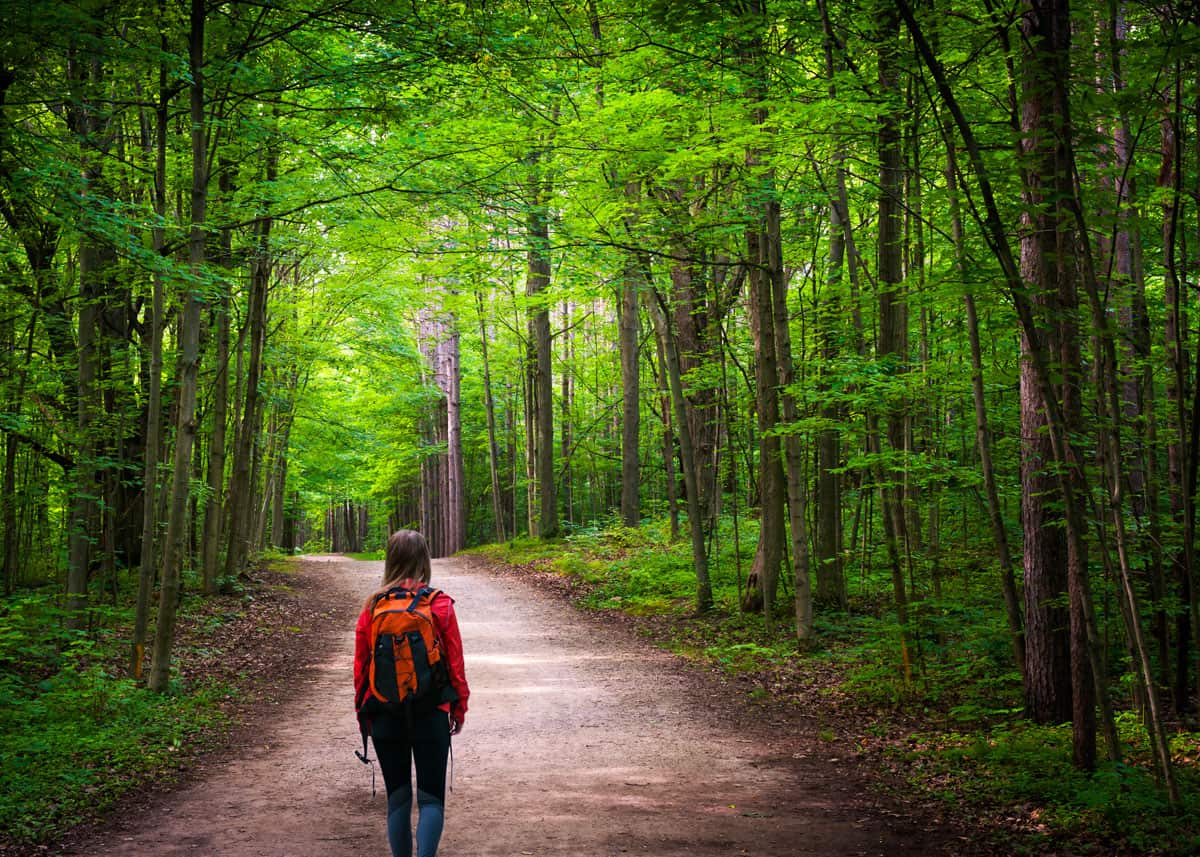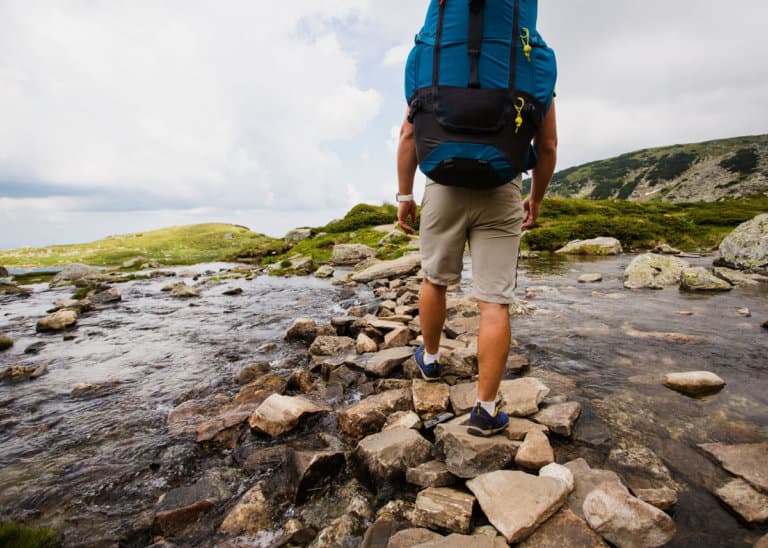Can You Squish a Tick? Plus 17 More Gross Tick Facts (Hunt, Feed, Kill)
Can you squish a tick? Should you? In this post, you’ll learn how to safely kill a tick, how they hunt, attach, drug, and then feed on you. You’ll learn about the diseases they carry, how often they feed, how to remove them, and how to prevent them.

For many people, snakes, spiders, scorpions, and ticks are the stuff of nightmares.
Ticks are known carriers of 16 diseases that can be passed onto humans. They are something to be aware of when spending time outdoors hiking and camping.
How much do you know about ticks? Here are 18 gross tick facts, covering everything tick-related like removal, types, diseases, and how they feed.
Can You Squish a Tick? 18 Tick Facts
It’s pretty comprehensive so we’ve broken it up into three sections: facts, feeding, and prevention.
Here are 18 disgusting facts about ticks:
1. Can you squish a tick?
The good news is yes; you can squish a tick.
But some are easier to squish than others. Just like tacos, ticks are either hard ticks or soft ticks.
- Soft ticks don’t have a shell, but rather tough leathery skin. They are easily squished.
- Hard ticks are harder to squish or crush.
Ticks aren’t easy to squish with your fingertips. Because they are so flat (when not engorged) your soft fingertips can be hard to exert enough pressure to crush it. I’ve seen pliers used quite effectively.
But maybe a better question is, should you squish a tick?
- Should I squish an embedded tick? Absolutely not! If you squeeze the tick, it will force the contents of the tick back into the host. Not only is this super gross – it is very dangerous. Ticks can carry many diseases. Injecting yourself with tick sludge and infection is a real possibility.
- Should I squish a tick to kill it? Probably not. While not as dangerous as the previous option, the tick is still full of dangerous infections. Why would you want to intentionally expose yourself to that?
Still want to kill that tick? Here are 5 ways to kill a tick besides squishing it.

2. Five safe ways to kill a tick
My favorites are the first two, heat and tape. They are both 100% effective.
- Heat: After possible exposure to ticks (hiking or camping trip) you can just toss your clothes into the wash. Ticks will die in water that is ≥54°C (≥130°F) according to a recent study. Or if clothes don’t need to be washed first, you can put them directly in your dryer – for a minimum of 6 minutes on high to effectively kill all ticks on your clothing. Another heat method is to toss the tick into your campfire.
- Tape it: This is probably the easiest method. Just stick the tick to a piece of packing or duct tape and then double it over. The tick can’t escape and it will die from lack of oxygen or desiccation (lack of water). You can just toss it into the garbage. If the tick had bitten someone, you might consider taping it to an index card, writing the date and other details on it. Some experts recommend keeping this for reference, should symptoms surface in the future.
- Alcohol: Using rubbing alcohol or mouthwash (alcohol-based) you can kill any tick. Just drop it/them into a liquid-filled container with a lid (making sure it can’t escape). It’s a slow process.
- Spray tick killer: This is most commonly used as a repellent but will work to kill ticks as well. JT Eaton makes a popular tick spray.
- Diatomaceous earth: This is for prevention – but still good to know about. Diatomaceous earth is an all-natural, non-toxic powder that will kill ants, bedbugs, and ticks.
My favorite method is to destroy it in the campfire. It’s quick and sanitary. If that isn’t a possibility, my second choice is to tape it. Both of these options are 100% effective – and keep my family free of possible contamination.
What about flushing a tick down the toilet? Yes, you can flush a tick to get rid of it. Ticks don’t swim but it is unlikely to kill them. Studies suggest that deer ticks can survive for 2-3 days underwater.
Flushing a tick should remove any threat to your family.

3. They hunt you with CO2 and temperature sensors
Using their Haller’s organ – located on the end of their front legs – they sense the carbon dioxide you release, every time you breathe.
Some species run towards the scent of CO2. Of course, this isn’t very fast – they have tiny legs. But how unnerving is that thought…
The Haller’s organ also senses temperature changes as you approach their location. A 2017 study showed that it also enabled them to see infrared (heat) energy from a warm-blooded host.
Straight out of a scary alien thriller, these tiny bloodsuckers can sense your breath, burps, and even your farts.
4. Hungry ticks are known as “Questing”
Ticks lazily take their perch, extend their feet, and wait for their next host to pass by. This behavior is called questing.
|
Others, though have a different approach.
Some adult ticks don’t simply lay in wait like most of the other ticks. Instead, they actively travel to their host. Especially while they are resting or sleeping.
5. They have claws on their feet
These claws make it possible for ticks to easily grab hold of passing hosts.
Each one of a ticks eight legs has seven segments and ends in a pair of claws, meaning they can cling to almost any surface.
That explains why they are so good at sticking around and not falling off a host before they have the chance to get where they want to go.
6. Their mouths are full of hooks
While both ticks and mosquitoes want our blood, that’s where the similarities end.
Mosquitoes insert their proboscis (mouth straw), suck your blood, remove their “straw” and fly away. It can take just a few seconds.
Ticks, on the other hand, tear into the flesh with two sets of opposing hooks. As they dig in, they insert the hypostome – a long, hook-filled straw device.
|
The backward-facing hooks act like an aggressive grappling hook – securing the tick so it can comfortably feed for the next 3 to 10 days.
An engorged tick becomes comically enlarged. Some adults can increase their weight 200X.
- Hard Ticks: Tick mouthparts are strong enough to pierce the skin, burrow down and suck blood, they are located on the front of its head. It is separate from the rest of the body and does not contain its eyes or brain, instead, it’s separate and a specialized adaptation.
- Soft ticks have their mouthparts underneath.

7. 16 Tick-Borne Viruses and Infections
There is no shortage of possible health problems from ticks.
Here are some diseases and infections that ticks can cause in the United States, according to CDC.
- Anaplasmosis: Carried by the black-legged tick (Ixodes scapularis) and the western black-legged tick (Ixodes pacificus). Formerly known as human granulocytic ehrlichiosis (HGE)
- Babesiosis: A protozoan infection (microscopic parasites) that infects red blood cells. Transmitted by the black-legged tick (Ixodes scapularis).
- Borrelia mayonii: This is a new species carried by the black-legged tick (Ixodes scapularis).
- Borrelia miyamotoi: Has a range similar to Lyme disease and is carried by the black-legged tick (Ixodes scapularis).
- Bourbon virus: Identified in a limited number of cases in the Midwest and southern US.
- Colorado tick fever: This virus occurs in the Rocky Mountain States (Colorado, Idaho, Montana, New Mexico, Utah, and Wyoming) at an altitude of 4,000 – 10,500 feet (1220 – 3200 meters) and is caused by the Rocky Mountain wood tick (Dermacentor andersoni).
- Ehrlichiosis: Caused by Ehrlichia chaffeensis and transmitted by the lone star tick (Ambylomma americanum).
- Heartland virus: Some studies indicate that the lone star tick (Ambylomma americanum) carry this.
- Lyme disease: The most famous (infamous) of all tick-borne diseases, it is transmitted by the blacklegged tick (Ixodes scapularis) and the western blacklegged tick (Ixodes pacificus).
- Powassan virus: Transmitted by the blacklegged tick (Ixodes scapularis) and the groundhog tick (Ixodes cookei).
- Rickettsia parkeri rickettsiosis: Carried and transmitted by the Gulf Coast tick (Amblyomma maculatum)
- Rocky Mountain spotted fever (RMSF): This is found in North, Central, and South America. In North America, it is transmitted by the brown dog tick (Rhipicephalus sangunineus), American dog tick (Dermacentor variabilis), and the Rocky Mountain wood tick (Dermacentor andersoni). In Central and South America, RMSF is transmitted by the brown dog tick and possibly other species.
- STARI (Southern tick-associated rash illness): The lone star tick (Ambylomma americanum) transmits this pathogen.
- Tickborne relapsing fever (TBRF): Transmission has been linked to soft ticks, and individuals sleeping in rustic (read: unclean) cabins in remote, mountains regions. It can be transmitted by ticks or fleas.
- Tularemia: This disease (bacterium Francisella tularensis) is transmitted by dog tick (Dermacentor variabilis), the wood tick (Dermacentor andersoni), and the lone star tick (Amblyomma americanum).
- 364D rickettsiosis (Rickettsia phillipi): This is a new disease, recently discovered in California and is transmitted by Pacific Coast tick (Dermacentor occidentalis ticks)
Here are the areas in Canada that pose the greatest risk for Lyme disease infection.
8. Surprise! Ticks are like spiders… not insects
Ticks are an arachnid which means they are more closely related to spiders and scorpions than insects.
Ticks are ectoparasites (external parasites). And most ticks belong to one of the following two families:
- Ixodidae or hard ticks
- Argasidae or soft ticks
9. Hard Ticks Feed 3 Times (3 Different Hosts)
- Ixodidae (hard ticks) have four life stages: egg, larva, nymph, and adult – each of the last three stages requiring a host for a blood meal.
- Argasidae (soft ticks) have the same primary stages, but can have up to seven nymphal stages – each one requiring a feeding – and a new host.
10. They make a sticky tick glue (cementum)
After they’ve found a good spot and attached, the tick excretes a natural bonding agent like a super glue which helps them to adhere their feeding tubes firmly into their host.
The glue is called cementum.
11. They have stealth mode (by drugging you with a saliva cocktail)
When a tick finds a nice place to set up camp, the reason you never realize they are there is because they inject you with a saliva cocktail.
It contains skin-numbing and blood-thinning agents along with a kind of neurotoxin that helps fight your immune system which is why it’s easier to contract diseases from them.
It is also the reason you don’t realize they are there because the skin around the bite site is numb.
In addition to the glue, they also excrete anti-inflammatory chemicals and antihistamines that numbs the skin and makes their presence almost impossible to detect.
If the bite was to become inflamed or infected, it would make it harder to feed – so they keep swelling reduced to almost zero. And the antihistamines prevent your body’s immune system from kicking that tick’s butt.
These chemicals are so good that most people don’t even feel them on their skin and don’t know they have a tick until it’s been hitch-hiking for a day or two.
12. They’re survivalists
When it is a long time between big blood meals, ticks can slow down, which means they can survive a long time without food, like nearly 7 months.
That is enough to last the winter – which explains why they come back year after year.
- Some tick larvae can live 1.5 years (540 days) without feeding.
- Some adult ticks can live for up to 3 years without feeding on a host.
Ticks can swim but can only survive underwater for a few days.
13. Tweezers, tweezers, tweezers
The best way to remove a tick is by grabbing it as close to the skin as possible with some sharp pointy tweezers and pulling with constant pressure.
If you freak out and try to pull it out with your fingertips, then there is a good chance you will rip the body out but the head will remain.
Here’s how to remove a tick head after the body is gone.
There are some tick removal kits – that will help remove the tick without squeezing the blood back into your body. Not a bad idea if you live in a tick area.
We have lots of ticks here in Nova Scotia (eastern Canada) so we have tick removal kits in our car and at home. They are cheap and allows me to safely remove a tick immediately.
14. Infection is not instantaneous
According to the CDC, if you remove a tick within 24 hours then the chances of catching Lyme disease are pretty low.
When the tick buries in and releases its saliva cocktail of toxins that help it feed, it can take 36 to 48 hours for the disease bacteria to adapt to infect you.
If you remove the tick quickly, within the first day then your chances of infection are lower. That’s why it’s a good idea to do a tick check in the shower after a hike.
15. They fed on dinosaurs
Ticks have been found preserved in amber from millions of years ago, so they’ve been around for a long, long time.
Found embedded in the amber right alongside dinosaur feathers means a flying dinosaur was probably its last meal!
16. Some ticks feed in ears and noses
Some species of ticks, like the Spinose Ear Tick, whose young specialize in living inside the ears of wild animals and cattle where it is nice and quiet and they can hang out gorging themselves for days, even weeks.
After a trip to Uganda in 2013, Tony Goldberg, a veterinary epidemiologist at the University of Wisconsin, found a new tick species inside his nose.
Areas where deer are present year-round, along with rivers and wooded areas have been found to be a good indicator of environments able to sustain dense tick populations.
These conditions along with not getting too cold are the perfect climate for ticks to have millions of little tick babies and thrive. When hiking in these areas, make sure to check for ticks at the end of the day.
17. Guinea Fowl love ticks
The biggest lover of ticks is the guinea fowl. The best-known eater of ticks, it will happily gorge itself picking them off grass, shrubs, the ground, greenery, and each other.
I had a friend who had these for that reason – he said there wasn’t a tick on his property after he purchased 40-odd birds.
Of course, these are loud birds – you’ll want some space between their roost and your house.

18. Do ticks smell when you kill them?
No. From my experience and research, ticks don’t have a smell – even when they are killed by being burst open.
On the other hand, ticks do have a keen sense of smell while they are still alive.

How Ticks Feed: From Questing to Engorged
When a tick is hanging out enjoying the sunshine on a blade of grass just waiting for a host to happen by it is called ‘questing’.
- Once they sense a host nearby through environmental changes, body odor, breath, and airflow, they simply jump on as you pass by. Some will attach swiftly and commence feeding while others will start their journey to a warm dark place before starting to feed.
- Once they have found a good spot, they cut your skin and release numbing agents so you don’t feel it.
- As they burrow in, they release anticoagulants so your blood won’t clot and just keeps coming. Once they have established themselves and cemented in their feeding tubes, they will then feed for days.
- Some ticks will engorge themselves so much that their weight increases by up to 200 times what it was before they settled in to feast on you.

Here are 7 tips to avoid ticks while hiking.
Tick Prevention
Wearing long pants is a great tick deterrent while hiking.
For added protection, you can spray your clothes with any bug spray you have on hand or there are products on the market specially made as a clothing insect repellent like Sawyer Products Permethrin clothing insect repellent.
For around the home and garden, there are tick yard sprays to keep you, your babies and your fur babies safe from any ticks that may wander into your yard.
Like Wondercide that is safe for your family and pets which is a great preventative spray killing and controlling ticks, fleas, and mosquitoes.
You might consider some homemade insect repellents – that work, even on ticks. And our very popular Campers Guide to Essential Oil Bug Repellent.
Overall, even if you take all of the preventative measures out there, these parasites have been doing this for a long time so at the end of each day spent out in the wilderness it is a good idea to do a tick search.
Here are the 5 best tick repellents for humans.
They prefer warm dark places like in your armpit, behind your ears or in your crotch, so basically anywhere you wouldn’t normally think to look… take a look.
Or get someone else to because there aren’t too many people that can see behind their own ear.

Your Turn
What fact did you love or totally gross you out? Have an experience or another fact to share? Let me know below!










This article made me aware of just how dangerous those tiny little bloodsucking actually are to both my dog and myself. Thank you for this very informative article, for it is good information to know and had some very strong points that people don’t usually hear about. It made me more cautious and aware of the dangers to the point that I will check myself and my dog regularly. So thank you.
I hate ticks, they are dangerous for people but also for animals. An excellent and educational article. Thanks!
Excellent article! Interesting and easy to understand. I found the numbing saliva and their survival rate most incredible. Also, that Guinea fowl eat them (nothing else???). There seems to be a bumper crop of ticks here in SE Wisconsin this year. I would run my pets to the vet to have them removed but with so many incidents, I had to learn how to deal with those tenacious critters myself.
I would like to know what does a tick do that has had his fill of blood? Does it release off the victim? Hang on and just hang out until discovered and removed? Would a tick just hang on a host for its entire life?
Also, where do ticks get these diseases they can potentially pass on?
Thank you!
@Annie Zaborski,
ticks will release themselves after feeding.
Are the ticks in Thailand dangerous?
@Asha,
Ticks are in Thailand and yes they are dangerous. Ticks are spreading worldwide along with lymes disease.
How soft are soft bodied ticks, Ornithodoros hermsi (possibly)? I think May have been bitten by one today while on a hike. I had part of a body (from either a soft bodied tick or spider) on the cuff of my white sweater. I’m not sure where it came from or when it ended up on the cuff of my sweater. Anyhow, I wiped it off with a paper towel and it easily squished and appeared to have blood in it. I’m trying to figure out if it was more likely a spider than a soft bodied tick but I can’t find a definitive answer about how easy is is to squish a soft bodied tick. Does it take any effort at all to squish a soft bodied tick? Are they really delicate?
Not really